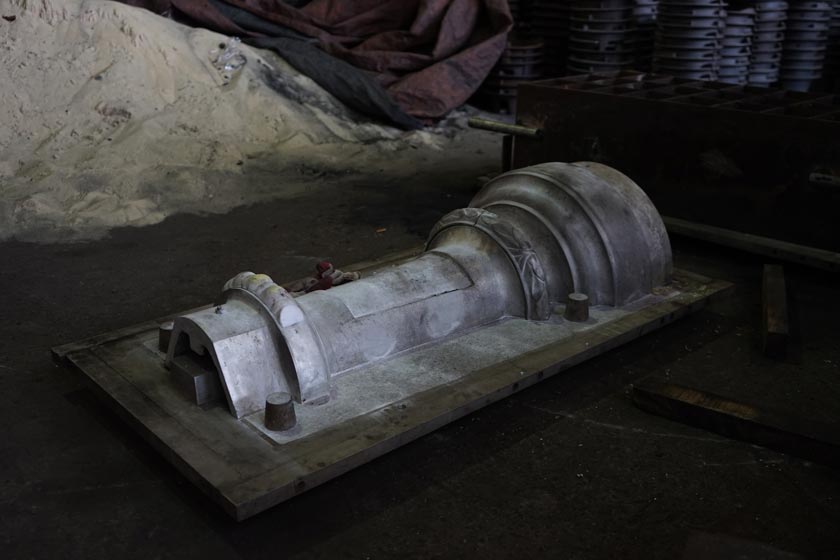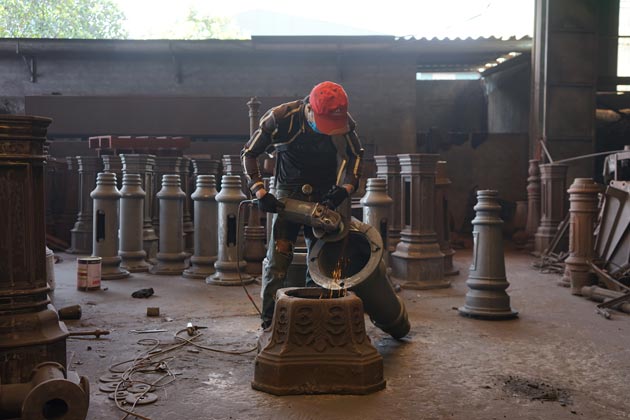How Aluminum Foundry Adds To Advancements in Aerospace Design
Aluminum shops are important to developments in aerospace design. They generate lightweight, high-strength parts that are important for modern aircraft. With advanced casting methods, these shops produce complicated geometries that improve structural honesty. Additionally, the advancement of exceptional Aluminum alloys sustains the industry's concentrate on fuel effectiveness and sustainability. Difficulties stay in the manufacturing process. Comprehending these factors exposes the profound effect of Aluminum on aviation's future.
The Relevance of Lightweight Materials in Aerospace Layout
As the aerospace sector remains to develop, the relevance of light-weight products ends up being significantly obvious. The need for effectiveness and sustainability drives engineers to prioritize the use of materials that reduce general weight without jeopardizing architectural stability. Light-weight products, particularly Aluminum, play an important duty in improving fuel efficiency, enhancing haul ability, and increasing the total efficiency of aircraft.
Moreover, the assimilation of these products enables ingenious styles, making it possible for producers to develop more aerodynamic shapes that can stand up to extreme problems. The decrease in weight not only lowers operational prices yet additionally adds to a reduced environmental footprint, aligning with international initiatives towards sustainability in air travel.
Advanced Casting Techniques in Aluminum Foundries
Advanced spreading strategies in Aluminum foundries play a vital duty in aerospace engineering by enabling the manufacturing of light-weight and specific components. Developments in mold and mildew style and accuracy spreading procedures are crucial in attaining excellent efficiency and architectural stability. In addition, the development of lightweight alloys boosts the total efficiency and performance of aerospace applications.
Ingenious Mold Layout
Ingenious mold layout plays an essential role in the effectiveness and performance of Aluminum foundries, specifically within the aerospace market. By leveraging innovative products and methods, contemporary mold and mildews can be engineered to hold up against heats and pressures, guaranteeing peak efficiency during the spreading procedure. These layouts commonly integrate complex geometries that permit the manufacturing of light-weight yet structurally sound parts, vital for aerospace applications. Additionally, using computer-aided design (CAD) software assists in precise modeling, allowing shops to mimic and improve mold and mildew layouts before physical production starts. This not only improves the quality of cast parts however additionally lowers waste and lead times, causing considerable expense savings. Overall, cutting-edge mold and mildew style is a foundation of development in Aluminum Foundry technology for aerospace engineering.
Accuracy Casting Procedures
The effectiveness of ingenious mold styles flawlessly incorporates with precision casting processes, which are essential for creating top quality Aluminum elements in aerospace engineering. These processes, consisting of sand casting, die spreading, and financial investment casting, ensure the creation of complex geometries with tight resistances. Advanced strategies like vacuum casting and stress pass away casting enhance the stability and surface coating of the end products. Accuracy casting minimizes material waste while maximizing the mechanical buildings of Aluminum, vital for aerospace applications. Furthermore, using real-time tracking and progressed simulation tools during the spreading process enables for immediate changes, causing boosted quality assurance. Collectively, these precision spreading procedures placement Aluminum factories at the leading edge of aerospace development, supporting the industry's need for reliability and efficiency.
Light-weight Alloy Advancement
As aerospace designers look for to boost fuel performance and performance, lightweight alloy development comes to be a necessary emphasis in Aluminum foundries. These factories employ innovative spreading methods to create alloys that provide superior strength-to-weight proportions. Innovations in alloy composition, consisting of the unification of elements like lithium and magnesium, make it possible for the production of products that endure extreme problems while decreasing overall airplane weight. Methods such as die spreading and investment spreading assist in the accuracy production of complicated shapes, which are essential for aerospace applications. Furthermore, continuous research aims to enhance these alloys for boosted mechanical buildings and enhanced resilience. By focusing on lightweight alloy development, Aluminum factories substantially add to the development of aerospace design, leading the way for a lot more effective and sustainable aircraft layouts.

Enhancing Structural Integrity Through Aluminum Components
Aluminum parts use substantial benefits in improving architectural stability within aerospace engineering. Their lightweight nature adds to general effectiveness while preserving stamina, which is necessary for airplane efficiency. Furthermore, the anxiety resistance properties of Aluminum aid assure the longevity and integrity of aerospace structures under various operational problems.
Light-weight Product Conveniences
While traditional materials commonly compromise weight for strength, making use of Aluminum elements in aerospace engineering provides significant advantages in structural honesty. Aluminum's lightweight nature adds to general layout performance, enabling more structured aircraft that consume less fuel, thus improving sustainability. The product's outstanding strength-to-weight proportion assurances that elements keep durability without adding unnecessary mass. This high quality cultivates enhanced performance and dexterity in trip, in visit site addition to enhanced haul capacities. Additionally, Aluminum's resistance to rust lengthens the life expectancy of aerospace frameworks, lowering maintenance expenses and improving safety and security. As producers increasingly adopt Aluminum alloys, the aerospace market experiences a transformative change in the direction of more reliable and efficient design remedies that focus on both performance and ecological responsibility.
Stress And Anxiety Resistance Features
Different products have unique residential or commercial properties, Aluminum's phenomenal anxiety resistance stands out as a crucial element in improving the structural stability of aerospace parts. This resistance plays a crucial function in making sure that airplane can withstand various operational tensions, consisting of exhaustion, influence, and environmental problems. Aluminum alloys, specifically engineered for aerospace applications, show high tensile toughness while maintaining light-weight attributes, enabling engineers to develop more effective frameworks - Aluminum Foundry. Furthermore, the ability of Aluminum to endure cyclic loading without considerable deformation adds to the longevity and integrity of aerospace parts. As innovations proceed in Aluminum Foundry methods, the development of stress-resistant Aluminum parts assures additional improvements in performance, safety and security, and performance throughout the aerospace market, strengthening Aluminum's function as a recommended material in modern-day engineering
Gas Effectiveness Improvements Driven by Aluminum Innovations
As the aerospace sector seeks to enhance fuel effectiveness, cutting-edge uses of Aluminum have arised as a necessary solution. Aluminum's lightweight nature significantly reduces aircraft weight, permitting lower gas usage throughout trip. This decrease in weight is essential, as even small reductions can lead to considerable renovations in total fuel economic climate.
Advanced Aluminum alloys, designed for improved toughness and durability, make it possible for makers to create parts that maintain architectural integrity while decreasing mass - Aluminum Foundry. Additionally, the combination of Aluminum in airframes and engine parts helps with boosted aerodynamics, adding click here to find out more to lowered drag and enhanced performance
The adoption of Aluminum in aerospace not just meets the need for fuel-efficient layout but also lines up with regulative pressures for reduced emissions. As these advancements continue to evolve, they play a significant duty in setting brand-new criteria for gas efficiency, making certain that the aerospace sector can meet growing ecological and financial difficulties.

The Function of Aluminum in Sustainable Aeronautics Practices
The enhancing focus on lasting air travel methods has actually positioned Aluminum as a vital product in the quest for greener airplane layout. Understood for its light-weight residential properties, Aluminum considerably reduces airplane weight, resulting in reduced gas intake and exhausts. Its recyclability better improves its sustainability profile, as Aluminum can be recycled indefinitely without loss of top quality. This particular sustains a round economic climate within the air travel market, reducing waste and source deficiency.
Improvements in Aluminum alloys have improved their toughness and deterioration resistance, permitting for longer solution life and lowered maintenance demands. These advancements help with the growth of much more efficient airplane structures, adding to general sustainability initiatives. In addition, Aluminum's thermal conductivity plays an essential role in energy-efficient layouts, improving systems such as warm exchangers. Jointly, these qualities emphasize Aluminum's essential duty in progressing lasting aviation, lining up with global campaigns targeted at decreasing the environmental impact of flight.
Challenges Dealt With by Aluminum Foundries in Aerospace Manufacturing
While Aluminum shops play a crucial duty in aerospace manufacturing, they encounter considerable obstacles that can influence production performance and high quality. One significant challenge is the stringent quality assurance requirements called for in the aerospace industry. Any issue can endanger security and efficiency, necessitating rigorous evaluation procedures that prolong manufacturing timelines. In addition, foundries commonly contend with varying basic material expenses, which can impact prices and productivity. The complexity of Aluminum alloys made use of in aerospace applications further makes complex the production procedure, as accurate solutions are crucial for attaining preferred mechanical residential properties. Competent labor shortages hinder the ability to maintain high-grade manufacturing degrees. Finally, environmental regulations enforce constraints on emissions and waste administration, requiring shops to buy lasting techniques, which can be cost-prohibitive. These elements jointly produce a landscape where Aluminum foundries need to constantly adapt to meet the developing demands of aerospace manufacturing while making sure safety and security and conformity.
Future Fads in Aluminum Applications for Aerospace Engineering
With improvements in technology and boosting demands for effectiveness, the future of Aluminum applications in aerospace engineering is positioned for significant transformation. The assimilation of ingenious Aluminum alloys and compounds is expected to improve strength-to-weight ratios, causing even more fuel-efficient airplane layouts. On top of that, improvements in additive production strategies will enable the production of intricate Aluminum structures that were previously impossible, enhancing efficiency and decreasing waste.

Sustainable techniques will play a vital role, with an expanding emphasis on recycling Aluminum to minimize environmental influence. The aerospace field is most likely to accept smarter making processes, such as automation and artificial knowledge, making sure higher high quality and precision in Aluminum components. Collaborations between Aluminum factories and aerospace firms will cultivate research and development, leading the means for brand-new applications that fulfill the rigid demands of contemporary aerospace engineering. Overall, the future looks assuring for Aluminum's duty fit the skies
Regularly Asked Concerns
What Are the Ecological Impacts of Aluminum Manufacturing in Aerospace?
The ecological effects of Aluminum production in aerospace include considerable energy consumption, greenhouse gas emissions, and habitat disturbance. Furthermore, mining processes can bring about soil deterioration and water contamination, increasing concerns about sustainability and eco-friendly balance.
How Does Aluminum Contrast to Various Other Materials in Aerospace Applications?
Aluminum supplies an one-of-a-kind combination of light-weight buildings, rust resistance, and cost-effectiveness contrasted to various other materials. Its high strength-to-weight ratio makes it particularly useful for aerospace applications, improving fuel effectiveness and general performance in aircraft layout.
What Credentials Do Aluminum Foundry Employees Demand for Aerospace Projects?
Aluminum Foundry workers require specialized training in metallurgy and spreading methods, in addition to knowledge of aerospace industry standards. Accreditations in quality assurance and security procedures are additionally important to guarantee compliance with rigorous aerospace job requirements.
Are There Any Type Of Safety Interest In Using Aluminum in Aerospace Engineering?
Safety and security concerns pertaining to Aluminum in aerospace design include vulnerability to tiredness, corrosion, and tension fractures. Proper treatment and alloy option are important to minimize these dangers, wikipedia reference ensuring structural integrity and overall safety in aerospace applications.
How Does Aluminum Recycling Benefit the Aerospace Industry?
Aluminum recycling greatly benefits the aerospace industry by decreasing material expenses, reducing environmental effect, and conserving energy. This lasting method improves the sector's efficiency while promoting making use of lightweight, high-performance elements in aircraft manufacturing.
Advanced spreading strategies in Aluminum shops play an important duty in aerospace design by making it possible for the manufacturing of lightweight and precise components. Ingenious mold style plays a vital function in the effectiveness and efficiency of Aluminum foundries, particularly within the aerospace field. As aerospace designers seek to boost gas performance and efficiency, light-weight alloy development ends up being a crucial focus in Aluminum shops. Aluminum alloys, specifically crafted for aerospace applications, display high tensile strength while maintaining lightweight attributes, making it possible for engineers to design a lot more efficient structures. Cooperations between Aluminum foundries and aerospace firms will foster study and growth, leading the means for new applications that meet the strict requirements of contemporary aerospace design.